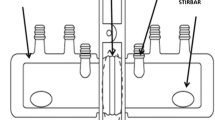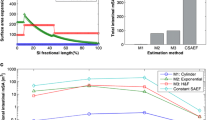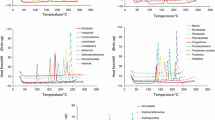Abstract
Purpose. Three new computational strategies have been evaluated for their ability to predict intestinal membrane permeability to a series of endothelin receptor antagonists.
Methods. The three methods were evaluated using a set of ten non-peptide endothelin receptor antagonists. The simplest method, 'the rule of five', is based on 2D parameters such as the number of potential hydrogen bonds, molecular weight and calculated lipophilicity. A method based on molecular mechanics calculations is used to calculate 3D parameters such as polar and non-polar parts of the molecular surface area. The third method uses quantum mechanics to calculate molecular properties related to the valence region.
Results. Descriptors derived by the latter two methods correlated well with permeability coefficients of the endothelin receptor antagonists. On the other hand, the rule of five failed to discriminate between drugs with high and low permeability.
Conclusions. Molecular surface descriptors and descriptors derived from quantum mechanics are potentially useful for the virtual screening of the permeability of the intestinal membrane to endothelin receptor antagonists.
Similar content being viewed by others
REFERENCES
C. A. Lipinski, F. Lombardo, B. W. Dominy, and P. J. Feeney. Experimental and computational approaches to estimate solubility and permeability in drug discovery and development settings. Adv. Drug Del. Rev. 23:3–25 (1997).
B. Testa and J. Caldwell. Prodrugs revisited: The “Ad Hoc” approach as a complement to ligand design. Med. Res. Rev. 16:233–241 (1996).
P. Lundahl and F. Beigi. Immobilized liposome chromatography of drugs for model analysis of drug-membrane interactions. Adv. Drug Del. Rev. 23:221–227 (1997).
C. Y. Yang, S. J. Cai, H. Liu, and C. Pidgeon. Immobilized artificial membranes—screens for drug membrane interactions. Adv. Drug Del. Rev. 23:229–256 (1997).
P. Artursson and R. T. Borchardt. Intestinal drug absorption and metabolism in cell cultures: Caco-2 and beyond. Pharm. Res. 14:1655–1658 (1997).
M. Kansy, F. Senner, and K. Gubernator. Physicochemical high throughput screening: parallel artificial membrane permeation assay in the description of passive absorption processes. J. Med. Chem. 41:1007–1010 (1998).
P. Garberg, P. Eriksson, N. Schipper, and B. Sjöström. Automated absorption assessment using Caco-2 cells cultured on both sides of polycarbonate membranes. Pharm. Res. 16:441–445 (1999).
R. A. Morrison. Automation, reliability and limitations of Caco-2 intestinal permeability screening for selection of well-absorbed drug candidates, Early ADME and toxicology in drug discovery. IBC Conferences USA, Berkeley, CA, USA (1998).
P. Artursson, K. Palm, and K. Luthman. Caco-2 monolayers in experimental and theoretical predictions of drug transport. Adv. Drug Del. Rev. 22:67–84 (1996).
Y. C. Martin. A practioner's perspective of the role of quantitative structure-activity analysis in medicinal chemistry. J. Med. Chem. 24:229–237 (1981).
P. S. Burton, R. A. Conradi, A. R. Hilgers, N. N. F. Ho, and L. L. Maggiora. The relationship between peptide structure and transport across epithelial cell monolayers. J. Contr. Rel. 19:87–98 (1992).
K. Palm, K. Luthman, A.-L. Ungell, G. Strandlund, and P. Artursson. Correlation of drug absorption with molecular surface properties. J. Pharm. Sci. 85:32–39 (1996).
K. Palm, K. Luthman, A.-L. Ungell, G. Strandlund, F. Beigi, P. Lundahl, and P. Artursson. Evaluation of dynamic polar molecular surface area as predictor of drug absorption: comparison with other computational and experimental predictors. J. Med. Chem. 41:5382–5392 (1998).
K. Palm, P. Stenberg, K. Luthman, and P. Artursson. Polar molecular surface properties predict the intestinal absorption of drugs in humans. Pharm. Res. 14:568–571 (1997).
P. Stenberg, K. Luthman, and P. Artursson. Prediction of membrane permeability to peptides from calculated dynamic molecular surface properties. Pharm. Res. 16:205–212 (1999).
J. T. Goodwin, P. S. Burton, A. R. Hilgers, R. A. Conradi, and N. N. F. Ho. Relationships between physicochemical properties for a series of peptides and membrane permeability in Caco-2 cells. Pharm. Res. 13:S243 (1996).
U. Norinder, T. Österberg, and P. Artursson. Theoretical calulation and prediction of Caco-2 cell permeability using MolSurf parametrization and PLS statistics. Pharm. Res. 14:1785–1790 (1997).
H. van de Waterbeemd, G. Camenisch, G. Folkers, and O. A. Raevsky. Estimation of Caco-2 cell permeability using calculated molecular descriptors. Quant. Struct.-Act. Relat. 15:480–490 (1996).
S. Winiwarter, N. M. Bonham, F. Ax, A. Hallberg, H. Lennernäs, and A. Karlen. Correlation of human jejunal permeability (in vivo) of drugs with experimentally and theoretically derived parameters. A multivariate data analysis approach. J. Med. Chem. 41:4939–4949 (1998).
E. H. Ohlstein, P. Nambi, A. Lago, D. W. Hay, G. Beck, K. L. Fong, E. P. Eddy, P. Smith, H. Ellens, and J. D. Elliott. Nonpeptide endothelin receptor antagonists. VI: Pharmacological characterization of SB 217242, a potent and highly bioavailable endothelin receptor antagonist. J. Pharmacol. Exp. Ther. 276:609–615 (1996).
H. Ellens, E. P. Eddy, C.-P. Lee, P. Dougherty, A. Largo, J.-N. Xiang, J. D. Elliott, H.-Y. Cheng, E. Ohlstein, and P. L. Smith. In vitro permeability screening for identification of orally bioavailable endothelin receptor antagonists. Adv. Drug Del. Rev. 23:99–109 (1997).
G. Chang, W. C Guida, and W. C. Still. An internal coordinate Monte Carlo method for searching conformational space. J. Am. Chem. Soc. 111:4379–4386 (1989).
F. Mohamadi, N. G. J. Richards, W. C. Guida, R. Liskamp, M. Lipton, C. Caufield, G. Chang, T. Hendrickson, and W. C. Still. MacroModel—An integrated software system for modeling organic and bioorganic molecules using molecular mechanics. J. Comp. Chem. 11:440–467 (1990).
MAREA v1.4, The program MAREA is available upon request from the authors. The program is provided free of charge for academic users. Contact Johan Gråsjö (email: johan.grasjo@galenik.uu.se).
J. J. Gajewski, K. E. Gilbert, and J. McKelvey. MMX an enhanced version of MM2. Adv. Mol. Model. 2:65–92 (1990).
K. B. Lipkowitz, B. Baker, and R. Larter. Dynamic molecular surface areas. J. Am. Chem. Soc. 111:7750–7753 (1989).
Spartan v5.0, Wavefunction Inc., 18401 Von Karman Avenue, Suite 370, Irvine, CA 92612 USA.
MolSurf v3.11, Qemist AB, Hertig Carls allé 29, SE-691 41 Karlskoga, Sweden. http://members.xoom.com/Qemist.
E. J. Jackson. A Users Guide to Principal Components, Wiley, New York, 1991.
A. Höskuldsson. PLS regression methods. J. Chemometrics 2:211–228 (1988).
Simca-S v6.01, Umetri AB, Box 7960, SE-907 19, Umeå, Sweden.
A. L. Ungell, S. Nylander, S. Bergstrand, A. Sjöberg, and H. Lennernäs. Membrane transport of drugs in different regions of the intestinal tract of the rat. J. Pharm. Sci. 87:360–366 (1998).
U. Norinder, P. Sjöberg, and T. Österberg. Theoretical calculation and prediction of brain-blood partitioning of organic solutes using MolSurf parametrization and PLS statistics. J. Pharm. Sci. 87:952–959 (1998).
Author information
Authors and Affiliations
Rights and permissions
About this article
Cite this article
Stenberg, P., Luthman, K., Ellens, H. et al. Prediction of the Intestinal Absorption of Endothelin Receptor Antagonists Using Three Theoretical Methods of Increasing Complexity. Pharm Res 16, 1520–1526 (1999). https://doi.org/10.1023/A:1015092201811
Issue Date:
DOI: https://doi.org/10.1023/A:1015092201811




